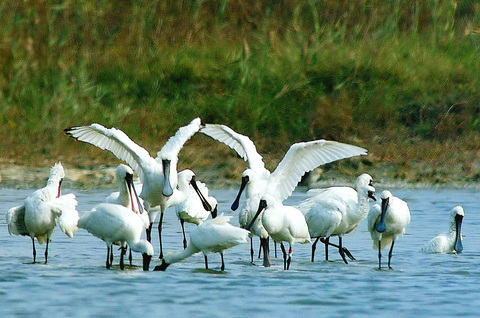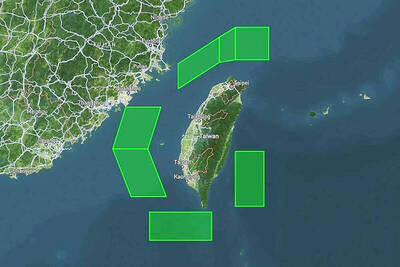At 757, Taiwan has seen a record high number of endangered black-faced spoonbills wintering in the southern part of the country, the Wild Bird Federation Taiwan said yesterday. The group made public their most up-to-date information on the species.
According to the federation, the record-high figure suggests an obvious improvement to the habitats where the birds spend the winter. At the same time last year, the number reported was only 628.

PHOTO: LIBERTY TIMES
On Sunday, a one-day global synchronic census on the endangered bird was carried out by conservationists associated with the federation. Yesterday, Fang Woei-horng (方偉宏), vice president of the federation, released a report on the census which shows that wetlands in Chiku, Tainan County, near Tsengwen Esturay is the most ideal site for the bird. Some 407 black-faced spoonbills were observed there. At wetlands in nearby Sitsao Township, 277 spoonbills were observed. Another 57 spoonbills were seen in the estuary of Bachang Creek, which straddles Tainan and Chiayi counties, four were seen in the Choshui estuary of Yunlin County, one at Chihpen wetland in eastern Taitung County and 11 at Wengdi wetland in northeastern Ilan County.
Federation secretary-general Chiang Kuen-dar (江昆達) told the Taipei Times yesterday that the result shows that conservation efforts made in the last decade have borne fruit.
"More wintering sites for the rare bird are now available. The number of spoonbills observed on wetlands in Sitsao, where is now an ecological reserve, has almost doubled since last year," Chiang said.
Since early September, the black-faced spoonbills returned to southern Taiwan earlier than they did in previous years, and in greater numbers. The peak number was measured in last month at 842.
Chiang said that some estuaries could be made into wintering sites for the bird if efforts were made to ensure proper habitat management.
Citing Aogu wetland near the estuary of Peikang River in Chiayi County as an example, Chiang said that bird watchers he talked to on Sunday said no spoonbills were spotted there. This is unusual, as the wetland is regarded by conservationists as one of the most important habitats for the wild bird, Chang said.
Conservationists soon figured out why the spoonbills were absent. Local authorities in the area destroyed 183kg of gunpowder at the ecologically sensitive site on Saturday, apparently driving the birds away.
Chiang said that a global census was conducted on the same day by conservationists in different countries, and a final report on the bird's global population would be released next month.
Black-faced spoonbills leave North Korea in winter for wetlands near river estuaries in the southern regions of Asia. They have been sighted along the southeast coast of China, Hong Kong, Macau, Taiwan, Japan, Vietnam and the Philippines. A global study conducted in January 1995 revealed that there were only 430 black-faced spoonbills in the world. However, the population has been growing, with a minimum of 1,069 counted in 2003 census and 1,206 last year.

Taiwan is to commence mass production of the Tien Kung (天弓, “Sky Bow”) III, IV and V missiles by the second quarter of this year if the legislature approves the government’s NT$1.25 trillion (US$39.78 billion) special defense budget, an official said yesterday. Commenting on condition of anonymity, a defense official with knowledge of the matter said that the advanced systems are expected to provide crucial capabilities against ballistic and cruise missiles for the proposed “T-Dome,” an advanced, multi-layered air defense network. The Tien Kung III is an air defense missile with a maximum interception altitude of 35km. The Tien Kung IV and V

The disruption of 941 flights in and out of Taiwan due to China’s large-scale military exercises was no accident, but rather the result of a “quasi-blockade” used to simulate creating the air and sea routes needed for an amphibious landing, a military expert said. The disruptions occurred on Tuesday and lasted about 10 hours as China conducted live-fire drills in the Taiwan Strait. The Civil Aviation Administration (CAA) said the exercises affected 857 international flights and 84 domestic flights, affecting more than 100,000 travelers. Su Tzu-yun (蘇紫雲), a research fellow at the government-sponsored Institute for National Defense and Security Research, said the air

Trips for more than 100,000 international and domestic air travelers could be disrupted as China launches a military exercise around Taiwan today, Taiwan’s Civil Aviation Administration (CAA) said yesterday. The exercise could affect nearly 900 flights scheduled to enter the Taipei Flight Information Region (FIR) during the exercise window, it added. A notice issued by the Chinese Civil Aviation Administration showed there would be seven temporary zones around the Taiwan Strait which would be used for live-fire exercises, lasting from 8am to 6pm today. All aircraft are prohibited from entering during exercise, it says. Taipei FIR has 14 international air routes and

Taiwan lacks effective and cost-efficient armaments to intercept rockets, making the planned “T-Dome” interception system necessary, two experts said on Tuesday. The concerns were raised after China’s military fired two waves of rockets during live-fire drills around Taiwan on Tuesday, part of two-day exercises code-named “Justice Mission 2025.” The first wave involved 17 rockets launched at 9am from Pingtan in China’s Fujian Province, according to Lieutenant General Hsieh Jih-sheng (謝日升) of the Office of the Deputy Chief of the General Staff for Intelligence at the Ministry of National Defense. Those rockets landed 70 nautical miles (129.6km) northeast of Keelung without flying over Taiwan,